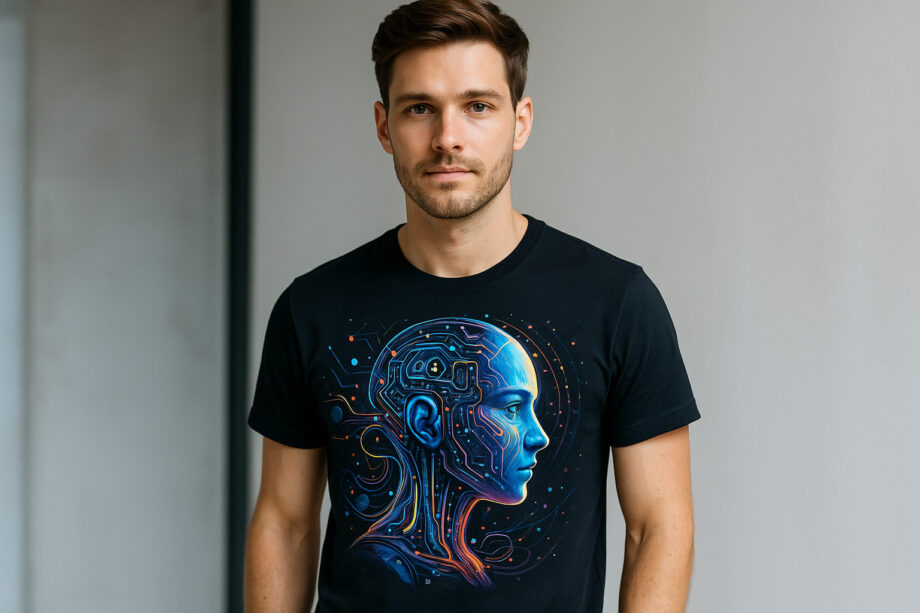Artificial intelligence is popping up everywhere in the fashion world these days, especially when it comes to shirts and unique apparel. If you’ve noticed designs that seem a bit more creative or patterns you haven’t seen before, chances are AI had a hand in making them. From the way shirts are designed to how we shop for them online, AI is mixing things up and making the whole experience more interesting for everyone involved. Let’s break down how AI is changing shirt design, the perks it brings, a few things to look out for, and what’s next for AI-powered fashion.
Introduction to AI in Fashion
AI isn’t just some futuristic idea for the fashion industry anymore—it’s already part of the process, helping brands and designers rethink how they approach everything from the first sketch to the final sale. Artificial intelligence in fashion is all about using smart algorithms to analyze what’s trending, predict what shoppers might want next, and make everything move a little faster and smoother. It’s not about robots sewing shirts; it’s more about giving designers new tools and helping customers find what feels right for them.
One way AI is making an impact is by sorting through mountains of data—think millions of photos, shopping histories, and trend reports—to help brands understand what people are actually wearing and buying. This lets designers make shirts that are more in tune with real-life preferences, instead of just guessing what might be popular. Personalization is a big deal too, with AI making it possible to recommend shirts based on your own style, size, and taste. The technology is weaving itself into the fabric of fashion, and it’s only going to get more common as brands look for ways to stand out and connect with shoppers.
How AI is Shaping Shirt Design
AI is bringing a fresh approach to shirt design that’s hard to ignore. Instead of relying just on human creativity (which is still super important), designers can now use AI tools to brainstorm and create new looks much faster. For example, AI-powered design tools can reduce the time to create a customized T-shirt from 2 hours to just 10 minutes. That’s a huge advantage for both brands and shoppers.
Here’s how it usually works: AI systems are fed a massive collection of shirt styles, colors, and patterns from past seasons and current trends. The AI then analyzes what’s getting the most attention, what’s fading out, and what could be the next big thing. Using this insight, it suggests new designs that combine trendy elements with fresh ideas that might not have come up in a regular brainstorming session. Sometimes, these tools can even generate dozens of unique shirt graphics or colorways with just a few clicks.
And it doesn’t stop at just creating new designs. AI also helps with customization for individual customers. You might upload a favorite image, describe your vibe, or answer a few style questions, and the AI will whip up a shirt that feels like it was made just for you. That level of personalization is something that’s getting more common, making shopping for shirts a lot more fun and tailored.
On the production side, AI-driven design tools are expected to reduce clothing design time by up to 30%. That means brands can move from idea to finished product much faster, keeping up with fast-moving trends and giving shoppers more of what they want, when they want it.
Benefits of AI-Generated Apparel
There are some clear perks to having AI involved in designing and selling shirts. First up, speed: AI’s ability to analyze data and spit out new ideas means brands can react to trends almost in real time, not months later. This is great for people who want to wear what’s hot right now without waiting for the next fashion cycle. Plus, AI-powered design tools can reduce the time to create a customized T-shirt from 2 hours to just 10 minutes, so you’re not stuck waiting for that perfect shirt to drop.
Shopping online for shirts gets a boost too. AI-powered virtual fitting rooms can increase online T-shirt sales by 30%. These digital fitting rooms let you “try on” shirts virtually, so you get a better idea of fit and look without stepping foot in a store. Not only does this make shopping more convenient, but it also helps reduce the number of returns, which is a win for both shoppers and brands.
Customer engagement is another area where AI is making a difference. AI-powered virtual fitting rooms increased customer engagement by 40%. When shoppers can interact with products in a more personal and fun way, they’re more likely to stick around, try new things, and actually make a purchase.
Trend forecasting has always been a guessing game, but AI is making it more accurate than ever. AI-driven trend forecasting tools can increase accuracy by over 85% compared to traditional methods. This means brands can plan better, avoid overproduction, and cut down on waste, making the entire industry a bit greener and more efficient.
Here’s a quick rundown of the main benefits of AI-generated apparel:
- Quicker design and production so new shirts hit the market faster
- Personalized shirt options that match your unique style
- Improved online shopping with virtual try-ons and better size recommendations
- Lower return rates thanks to more accurate product suggestions
- Better trend forecasting so brands can make what people really want
For brands like https://www.thisshirtexists.com, all these benefits mean more creative products, happier customers, and a business that’s ready to keep up with what’s next in fashion.
Challenges and Ethical Considerations
While AI is helping brands and shoppers in a bunch of ways, it also brings up some important questions. For starters, there’s the issue of creativity. If a machine is designing shirts, how much of the creative spark is really human? Some people worry that relying too much on AI could make fashion feel less personal or original, even though it also opens up new possibilities for inspiration.
Data privacy is another big concern. AI systems often need access to lots of personal information—what you like, what you buy, your measurements—so they can make good recommendations. Brands have to be super clear about how they use and protect this data to keep customers’ trust and avoid privacy issues.
There’s also the question of jobs. As AI takes over some parts of the design and retail process, traditional roles might change or disappear. On the bright side, AI can also create new jobs by giving designers more advanced tools and opening up opportunities for tech-savvy creatives to work in fashion.
Copyright and originality are worth thinking about too. When AI analyzes millions of existing shirt designs, it can be tricky to make sure new creations aren’t just copies or mashups of other artists’ work. Brands need to set clear rules and check for originality to stay on the right side of copyright laws as AI-generated apparel gets more popular.
Future Trends in AI-Driven Fashion
Looking ahead, AI’s role in fashion is only going to get bigger and more interesting. One major trend is hyper-personalization, where shirts and other apparel feel like they’re made just for you—right down to the fit, color, and style details you like best.
Tech like AR (augmented reality) and VR (virtual reality) is coming together with AI to make shopping even more interactive. Imagine using your phone or computer to see yourself in dozens of AI-generated shirt designs without leaving home. This makes online shopping a lot more immersive and can help cut down on wasted inventory and returns.
Sustainability is another big focus for brands using AI. By analyzing production methods and materials, AI can help companies reduce waste, choose greener fabrics, and streamline logistics. This is a step toward more eco-friendly fashion that’s good for shoppers and the planet.
Real-time trend tracking is making it easier for brands to spot new styles the moment they catch on, so you’ll see shirts inspired by the latest memes, art, or pop culture almost instantly. AI-driven trend forecasting tools can increase accuracy by over 85% compared to traditional methods, which means brands can deliver the right designs at the right time.
Here’s what we’re likely to see more of in the future:
- More customization so shirts really reflect your personal style
- Greener, smarter production that cuts down on waste
- Interactive shopping experiences using AR and VR
- Collaboration between designers and AI for even more creative ideas
- Greater transparency around how clothes are made and sourced
Ultimately, AI-generated shirts are helping to make fashion more creative, personal, and efficient—not just a passing trend, but a fresh way to think about what you wear. As technology keeps moving forward, keep an eye on brands like https://www.thisshirtexists.com that are bringing smart, original designs to life thanks to AI.


